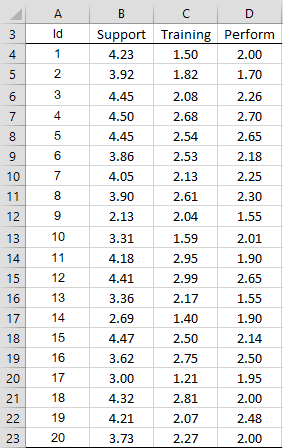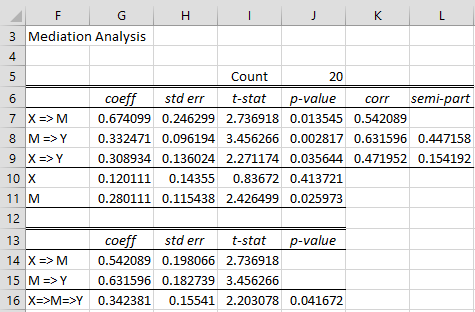Overview
Mediation Analysis models a hypothetical causal sequence in which variable X affects outcome Y indirectly through mediator variable M, and tests whether variable M indeed mediates the relationship between X and Y (see Figure 1).
Figure 1 – Mediator relationship between X and Y
According to Baron and Kenny, we have a mediation relationship provided four conditions are met:
- There is a significant relationship between X and M (path a)
- There is a significant relationship between M and Y (path b)
- Also, there is a significant relationship between X and Y (path c)
Requirement 1 means that the independent variable X is significant in the linear regression model with M as the dependent variable, and similarly for requirements 2 and 3. The fourth requirement is:
- In the regression model with X and M as independent variables and Y as the dependent variable, the impact of path c is greatly reduced.
Requirement 4 means that the X coefficient in this regression becomes non-significant or at least its significance is greatly reduced. This can also mean that the semi-partial correlation of Y on X factoring out M noticeably drops.
Example
Example 1: Determining whether a father’s emotional support for his daughter (M) is a mediating factor in the relationship between the father’s training of his daughter in football skills (X) and the daughter’s performance in playing football (Y) based on the data in Figure 2.
Figure 2 – Mediation Analysis Data
Requirement 1
We now check the four requirements. For requirement 1, we use the Real Statistics Multiple Regression data analysis tool with the Input X range C3:C23 and the Input Y range B3:B23 (path a). The coefficient portion of the output is shown in Figure 3.
Figure 3 – Regression coefficients for requirement #1
We see that the p-value = 0.013545, which is significant.
Requirements 2 and 3
We now create three more regressions to determine whether requirements 2, 3, and 4 are satisfied. The results are summarized in range F6:L11 of Figure 4.
Figure 4 – Mediation Analysis
Row 7 (path a) shows the results from Figure 3. Note that the values in range G7:H7 are calculated by the array formula
=SUBMATRIX(RegCoeff(C4:C23,B4:B23),2,1)
Here, RegCoeff is used to calculate the regression coefficients (intercept and X), and SUBMATRIX is used to suppress the display of the intercept coefficient, which is not needed for the analysis.
As usual, the t statistic (cell I7) is calculated by the formula =G7/H7 and the p-value (cell J7) by the formula =T.DIST.2T(ABS(I7),J$5-2).
Row 8 (path b) is calculated in the same way using the X range B4:B23 and Y range D4:D23, while row 9 (path c) is calculated using the X range C4:BC3 and Y range D4:D23. Since the p-values in cells J8 and J9 are both significant (based on α = .05), we see that requirements 1, 2, and 3 have been satisfied.
Requirement 4
To test requirement 4, we need to perform regression using the X range B4:C23 and the Y range D4:D23. This is done by placing the array formula
=SUBMATRIX(RegCoeff(MERGE(B4:B23,C4:C23),D4:D23),2,1)
in range G10:H12 to calculate the relevant regression coefficients. We see that the p-value for the mediator M (cell J11) is still significant, while the p-value for X (cell J10) has increased dramatically (and is in fact now not even significant).
Note too that the correlation between X and Y (cell K9) is .47, as calculated by =CORREL(C4:C23,D4:D23), while the correlation between X and Y when the effect of M is factored out (cell L9) falls to .15, as calculated by
=SEMIPART_CORREL(D4:D23,C4:C23,B4:B23)
This supports requirement 4. If the X coefficient is still significant when testing requirement 4, we can use the Sobel test. See Sobel Test for more details.
References
Kenny, D. A. (2021) Mediation
https://davidakenny.net/cm/mediate.htm
Baron, R. M., & Kenny, D. A. (1986). The moderator-mediator variable distinction in social psychological research: Conceptual, strategic and statistical considerations. Journal of Personality and Social Psychology, 51, 1173-1182.
http://dx.doi.org/10.1037//0022-3514.51.6.1173



